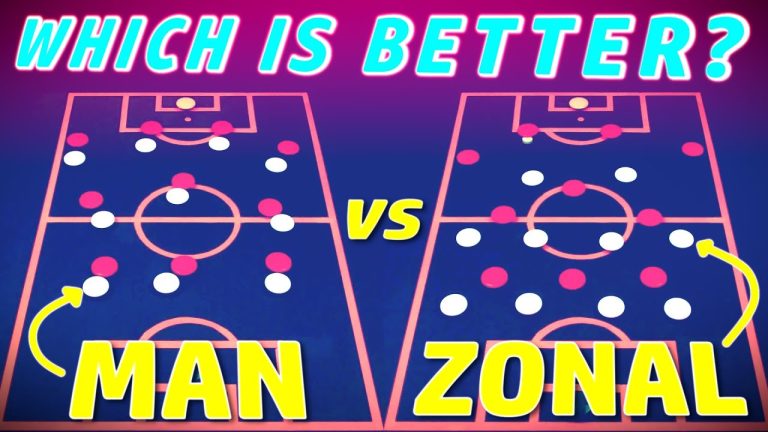Zonal marking principles have revolutionized the way teams approach defense in the world of football. By assigning players specific zones to cover rather than marking individual opponents, teams have found a more organized and strategic way to defend their goal. This article explores the key concepts behind zonal marking, highlighting its effectiveness in preventing goals and disrupting the opposition’s attacking play. From the iconic AC Milan side of the 1990s to the modern-day Barcelona, zonal marking has become a cornerstone of many successful teams. Join us as we delve into the intricacies of this tactical approach and understand why it has become a game-changer in the beautiful game.
How is zonal marking operational?
Zonal marking, a defensive strategy used in soccer, focuses on controlling and defending specific areas of the field rather than marking individual players. By assigning players to specific zones, teams aim to restrict the opposition’s attacking options and maintain defensive solidity. This approach proves particularly effective when defending set-pieces, as players are positioned strategically to cover areas and intercept any incoming threats. Zonal marking offers a cohesive and organized defensive structure, allowing teams to anticipate and react to the movements of the opposition, ultimately minimizing their scoring opportunities.
In zonal marking, the emphasis shifts from man-to-man marking to spatial control, making it a more proactive defensive approach. By prioritizing the protection of spaces, teams can neutralize the opposition’s attacking threats and maintain a compact defensive shape. This strategy requires coordination and communication among players to ensure effective coverage of zones and timely interceptions. Zonal marking also allows teams to quickly transition from defense to attack, as players are already positioned in strategic areas to initiate counter-attacks. Overall, zonal marking offers a modern and tactical defensive strategy that can be employed to great effect in both open play and defending set-pieces.
What does the zonal marking analysis entail?
Zonal marking analysis is a defensive strategy in football where players focus on covering specific areas of the field rather than individual opponents. Instead of reacting to the movement of the opposition, this tactic aims to ensure that crucial spaces are always guarded, leaving no free pockets for the opponents to exploit. By implementing zonal marking, teams can effectively limit their opponents’ attacking options and maintain a strong defensive structure.
This approach to defense emphasizes the importance of teamwork and coordination among players. Each individual is assigned a specific zone to cover, ensuring comprehensive coverage of the pitch. Zonal marking allows teams to maintain a solid defensive shape, making it difficult for the opposition to penetrate through the defensive lines. By prioritizing space over individual players, this strategy can be a highly effective way to neutralize the opposition’s attacking threats and maintain control of the game.
What are some examples of zonal marking?
Zonal marking is a tactical approach in football where players are responsible for defending specific zones rather than marking individual opponents. Walid Regragui’s Morocco serves as a prime illustration of this strategy. With position-oriented zonal marking, Regragui allowed the opposition some freedom on the wings, but cleverly constructed multiple defensive blocks in defense and midfield. The objective was to minimize gaps and the space between the lines, ultimately thwarting the opponent’s attacking opportunities.
Regragui’s implementation of zonal marking showcases the effectiveness of this tactical approach. By assigning players to specific zones, Morocco’s defense becomes compact and organized, making it difficult for the opposition to penetrate. The deliberate decision to sacrifice some space on the wings is a calculated risk, as it allows the team to focus on creating defensive layers centrally. This approach not only limits the opponent’s attacking options but also enables quick transitions and counterattacks. Overall, Regragui’s Morocco exemplifies the strategic value of zonal marking in modern football.
Master the Field: Unleashing the Power of Zonal Marking
Master the Field: Unleashing the Power of Zonal Marking
In the world of soccer, zonal marking has emerged as a revolutionary defensive tactic that has the potential to transform the game. By dividing the field into different zones and assigning each player a specific area to defend, teams can effectively neutralize their opponents’ attacking threats. This strategic approach allows for seamless coordination among players, as they work together to close down spaces and intercept passes. With zonal marking, defenders can quickly identify and nullify the danger, making it extremely difficult for the opposition to penetrate their lines. By mastering the art of zonal marking, teams can gain a distinct advantage on the field, stifling their opponents’ creativity and dictating the flow of the game.
Unlocking Tactical Brilliance: The Secrets of Zonal Marking
Unlocking Tactical Brilliance: The Secrets of Zonal Marking
In the world of football, zonal marking has emerged as a tactical strategy that has revolutionized the game. By dividing the field into different zones and assigning players specific areas to cover, teams are able to effectively neutralize the opposition’s attacking threat while maintaining a solid defensive structure. This approach not only allows for better teamwork and coordination but also enables players to anticipate and intercept passes, leading to more successful defensive transitions and counterattacks. Furthermore, zonal marking promotes a proactive style of play, as players are constantly positioned to anticipate and react to potential threats. With its ability to create a formidable defensive unit and exploit the weaknesses of the opponent, zonal marking has become an essential tool in the arsenal of successful football teams, unlocking tactical brilliance on the field.
From Theory to Victory: Winning Strategies with Zonal Marking
From Theory to Victory: Winning Strategies with Zonal Marking
Mastering the art of zonal marking can be the key to unlocking success on the football field. By strategically positioning players within specific zones, teams can effectively neutralize opponents’ attacks and create scoring opportunities of their own. This defensive strategy requires discipline, coordination, and a deep understanding of the game, but when executed flawlessly, it can lead to triumph. With zonal marking, players become an impenetrable force, intercepting passes, closing down spaces, and frustrating the opposition. By seamlessly transitioning from theory to victory, teams can harness the power of zonal marking and claim their spot at the top of the game.
The beauty of zonal marking lies in its ability to seamlessly connect theory with on-field success. Coaches must meticulously analyze their opponents, identify their weaknesses, and devise a strategic plan to exploit them. By assigning players to specific zones, teams can effectively nullify the opposition’s attacking threats and maintain defensive solidity. Simultaneously, zonal marking creates opportunities for counterattacks and fluid team movement, as players can anticipate and intercept passes with precision. This tactical approach revolutionizes the game, transforming it into a chess match where every move has a purpose. From theory to victory, zonal marking has the potential to redefine the way football is played and propel teams towards greatness.
Incorporating zonal marking principles into a team’s defensive strategy can significantly enhance their overall performance on the field. By assigning players specific areas to cover rather than man-marking opponents, teams can effectively neutralize threats and maintain a compact defensive shape. This approach not only reduces the risk of individual errors but also encourages better communication and teamwork among players. Ultimately, adopting zonal marking principles fosters a more cohesive and organized defensive unit, leading to improved results and an increased chance of success in competitive matches.



